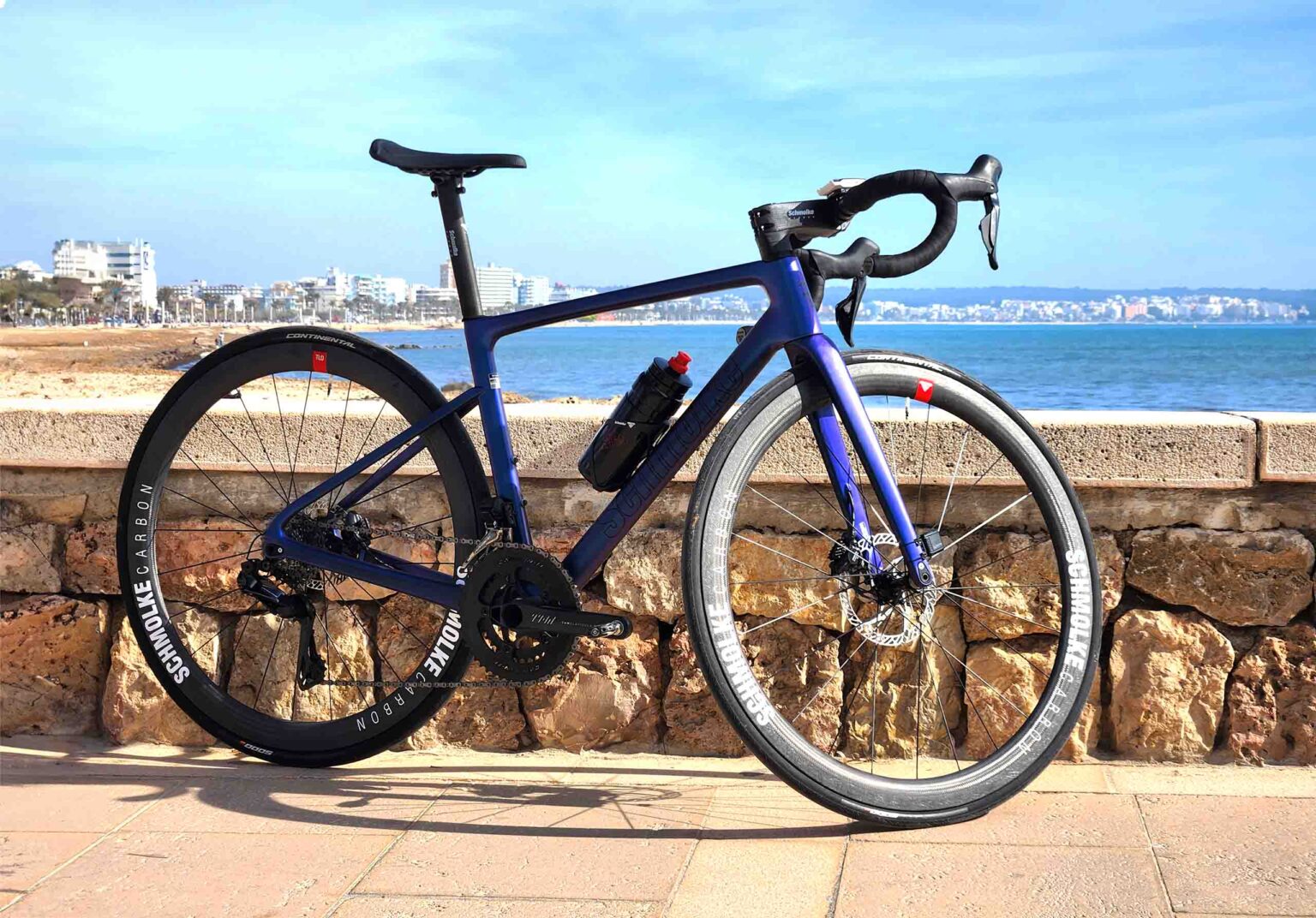
Test the Aerrow road bike on Mallorca
Our Aerrow test bike fleet is ready for test rides on Mallorca in Platja de Palma until Monday, March 25th. Every day from 3:30 p.m. Stefan Schmolke, founder and owner of Schmolke Carbon, will be

The commonly used term „carbon“ means „carbon fiber reinforced plastic“. For this purpose, carbon fibers are embedded in a plastic matrix for reinforcement. Carbon fibers are industrially produced fibers made from carbon-containing raw materials that are converted into graphite-like carbon by special thermal processes. Carbon fibers are extraordinarily light and strong. In order to be able to use them, the filaments, which are only 5-8 µm thin, are bound into a plastic matrix in the form of rovings (strands) in fabrics and unidirectional layers.
The first bike parts were made of from carbon fiber reinforced plastics – CFRP for short – a dry carbon fiber fabric coated with liquid epoxy resin at the end of the 1980s. After some time, so-called prepregs were used, i.e. pre-impregnated carbon fibers in which the fibers are already soaked in an uncured plastic matrix. This resulted in a higher quality due to a more even distribution of the epoxy resin.
SCHMOLKE Carbon was there from the beginning and already gained experience with dry carbon fiber fabrics. For quality reasons, we relied on prepregs very early on, which at the time were only used in aerospace technology for cost reasons.
Over the years, the quality of the raw materials, especially the fibers, continued to develop, and with it, the quality of SCHMOLKE products. The further development of the fibers since 2000 alone has made it possible to double their breaking strength. Since SCHMOLKE Carbon always relies on the best materials, we are always able to extend our technological lead over competitors.
Our rims are the first automatically produced SCHMOLKE carbon components, as they are braided in a circle practically infinitely from only 6 rovings on a large braiding rotor. Since the automotive industry discovered carbon as an image-enhancing material, automation in carbon processing has been rapidly advancing. This will enable us to continue producing in Germany.
The automation offers constantly reproducible fiber placement, so that the fibers in our rims are always perfectly aligned. However, with prepregs it is currently possible to deposit in a more differentiated way, which is why we continue to produce the more complicated components with prepreg.
Carbon fibers, and the material carbon, are characterized by possessing extreme strength, stiffness and low weight. The anisotropy of carbon fibers is also remarkable. What does that mean? Metals bear loads in all directions approximately equally well. This behavior is called „isotropy“. Carbon fiber-reinforced plastics, on the other hand, bear loads in the direction of the fibers much better than across them. They mainly withstand tensile forces in the axial direction; they withstand compressive loads only about half as well. This property is called „anisotropy“.
However, the anisotropic properties of the material also make it possible to use carbon fibers only in the direction of the forces that occur, thus sparing material and shaving weight. This requires a mature knowledge of the forces and stresses occurring in the component during development, so that the internal structure of the components also does justice to the course of the forces. Years of experience in the design and manufacture of very different carbon components are the basic prerequisite for products that meet the highest quality and performance standards.
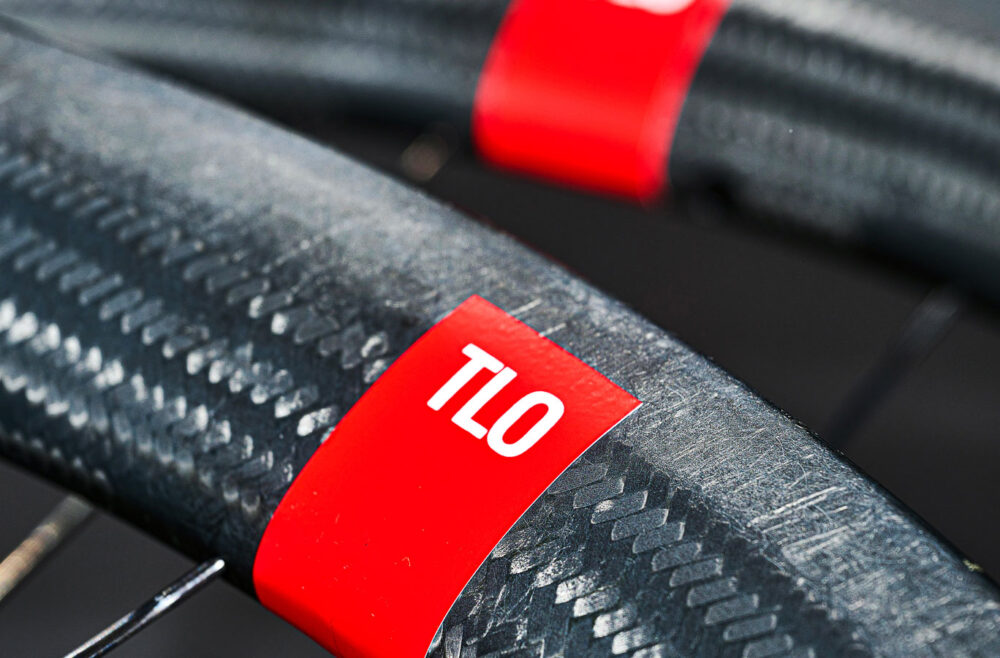
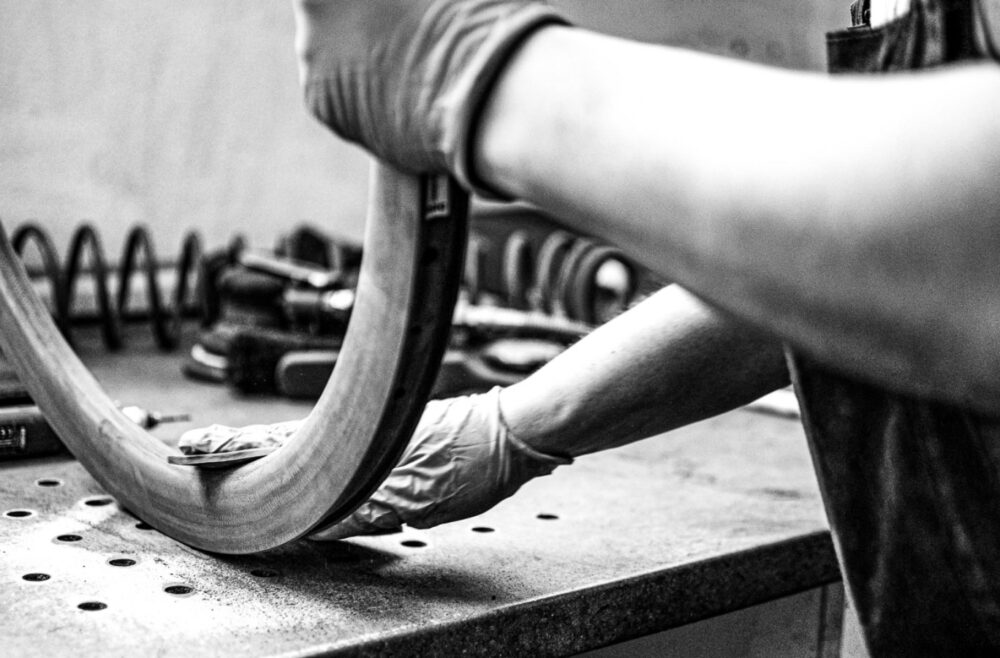
Tensile loads are the ideal forces for carbon fibers. Bending loads always contain tensile components and are therefore also well tolerated by the material. The advantage of carbon over other materials, on the other hand, is less effective with multi-axial stress conditions (i.e. with loads in different directions). These stress states occur especially at those points where the component is additionally loaded with pressure, as is predominantly the case in the clamping area. These special loads are analyzed and the component is reinforced accordingly. However, and in order to not overcompensate with unnecessary carbon, it is essential that the clamping forces do not exceed defined values.
IMPORTANT: It is therefore essential to observe the maximum permitted tightening torques and only clamp in the designated and marked area.
As resilient as carbon parts are, excessive clamping forces are their Achilles’ heel!
As everywhere, quality has its price. SCHMOLKE Carbon aims to build light and intelligent at the same time. This means that we design our products according to your ideas and demands. In addition to the rider’s weight and handling, the riding performance plays a decisive role. The individual production is not only reflected in the different dimensions of the components, but also and especially in the internal construction. For example, each handlebar and each seatpost is handmade according to its own plan, which provides for the optimal occupancy and wall thickness according to the load. However, since we do not only design for lightness, but above all for stiffness (except for our seat posts), our components are designed in such a way that they still have sufficient safety reserves for extraordinary load situations despite their low weight.
In order to guarantee consistently high quality, we consistently rely on development and production in the high-tech country of Germany. Another qualitative difference to our competitors lies in the carbon fibers used. Here we use only the highest quality fibers. As can be seen in the diagram below, the T1000 fibers used in our TLO series have a 30% higher tensile strength than the T700 fibers usually used in the bicycle industry. The T1000 fibers are also twice as expensive.
The proven SCHMOLKE quality results not least from attention to detail. For example, we use numerous, thin layers, which allows us to reproduce the occurring loads more precisely. The multilayer structure also results in better fatigue strength and therefore more durable products. In addition, multi-layer constructions consisting of many thin layers have a more favorable fracture behavior in extreme cases: In contrast to simple constructions made of a few thicker layers, they are less frail and are therefore more reliable and safer.
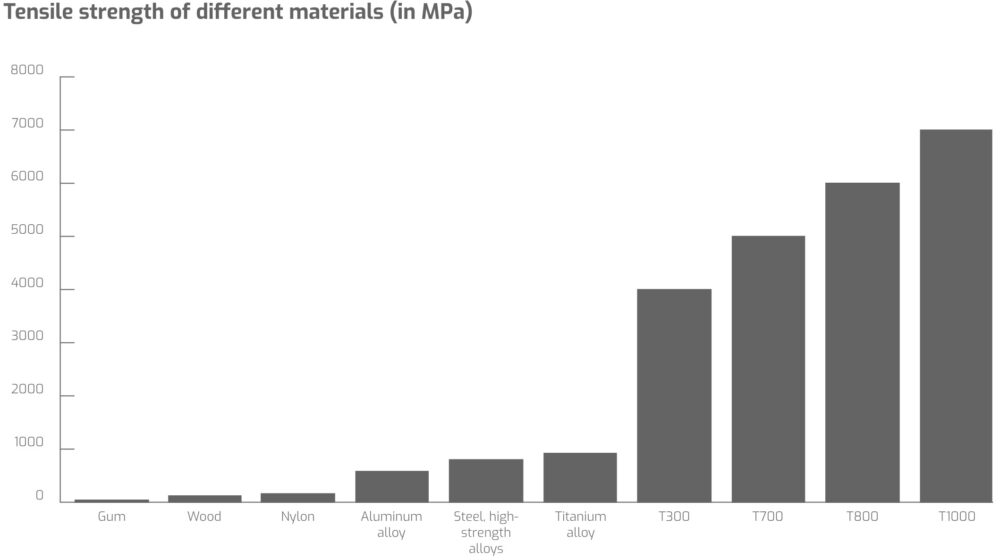
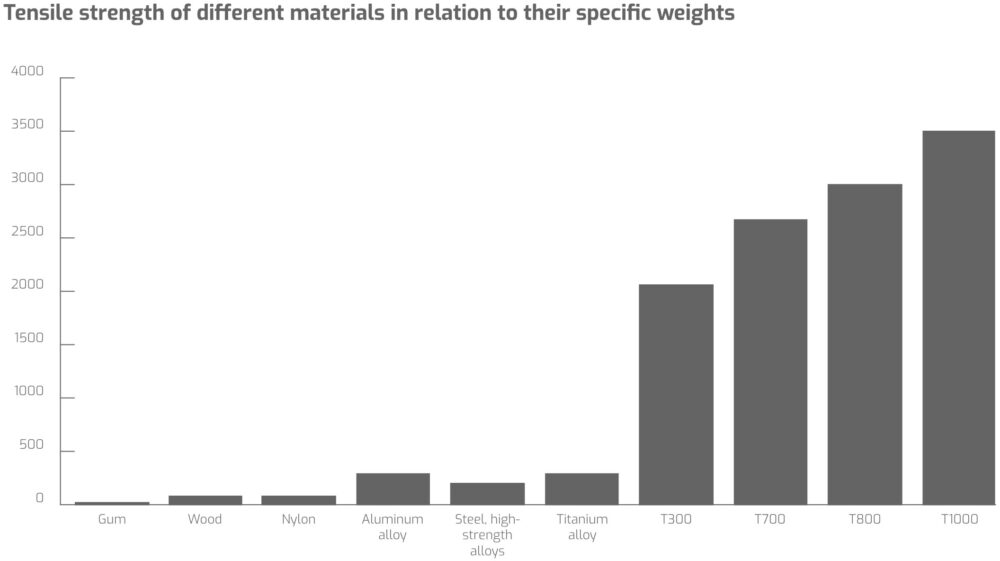
The proven SCHMOLKE quality results not least from attention to detail. For example, we use numerous, thin layers, which allows us to reproduce the occurring loads more precisely. The multilayer structure also results in better fatigue strength and therefore more durable products. In addition, multi-layer constructions consisting of many thin layers have a more favourable fracture behaviour in extreme cases: In contrast to simple constructions made of a few thicker layers, they break less brittly and are therefore more reliable and safer.
Since 2007, terms such as 1K or 3K have often been used in advertising texts in relation to carbon. This refers to the amount of tiny carbon fibers (filaments) that are combined in a bundle (roving). 1K stands for 1000 filaments, 3K for 3000 filaments, and so on.
The bundles are woven together biaxially (i.e. in 2 different directions, e.g. 0°/90°) to form a fabric. The differences between the types of fabric are mainly of optical importance.
UD is the unidirectional arrangement (running in only one direction) of the fibers. In this case, the fibers lie parallel to each other and without cross-connections; they are not interwoven with each other. It is therefore completely irrelevant whether 1K, 3K or 12K rovings are used, the only decisive factor is the total number of fibers laid, i.e. the weight per unit area of the individual layers. However, this is not mentioned in the advertising.
Compared to woven fabrics, UD has not only optical but also mechanical differences. The carbon fibers in woven fabrics are slightly bent due to the weaving process, which insignificantly reduces the tensile and flexural strength of the fibers, which are deflected from their ideal flat position. This results in a slightly higher load-bearing capacity of the UD fabrics, causing them to break slightly later in the event of failure. However, a woven fabric provides a net-like bond that counteracts crack propagation in the event of fracture.
Hence, the exclusive use of UD fibers might still make sense for the frame, since here several tubes always bear weight and the brittle breakage of a tube does not usually lead to a fall straight away. For our safety-relevant components, we are skeptical about the UD trend. On request, we nevertheless manufacture handlebars and seat posts with UD fiber surfaces, but for your safety we still use a fabric component inside to prevent the brittle fracture behavior and rapid crack propagation.
The oversize trend, i.e. dimensioning components for a clamping dimension of 31.8 mm, can be assessed from different angles. Basically, the fact applies that as the diameter of the tubes increases, the bending stiffness increases disproportionately while the weight remains the same (by reducing the wall thickness). Accordingly, it would make sense to increase the pipe diameter and reduce the material thickness accordingly.
However, this increase of the pipe diameter with a simultaneous reduction of the wall thicknesses comes up against limits: With decreasing wall thicknesses, the stability of the tubes against compressive stresses decreases – the well-known cola can effect causes the tube to buckle. Since carbon is particularly good at withstanding tensile stresses, but only to a lesser extent compressive stresses, the advantages of the OS geometry do not come to bear so clearly with this material. Due to the particularly high compressive forces acting in the clamping area, this must be especially reinforced.
Our oversize racing handlebar, the lightest in the world, weighs even 5 g more than the racing handlebar with the 26 mm clamp, but offers higher stiffness and an ergonomic hand rest, as the wide cross-section is used consistently over the entire middle section.
Our 27.2 mm seat post, the lightest in the world, weighs 5 g less than a 31.6 mm seat post with the same length and pressure stability in the clamping area. However, because the diameter is included in the formula of the moment of resistance against bending with the 3rd power, the thin seat post is considerably more elastic. This makes our 27.2 mm seat post, which is as long as possible, the most comfortable seat post in the world.
„SL“ stands for super light. In this series, we only use T800 quality fibers for our handlebars and seatposts, whereas fibers of T300 to T700 quality are usually used in the industry. In addition, low weight stability is made possible by the load-oriented layer structure.
„TLO“ – „The Lightest One“. Even lighter than SL and without compromising on strength and stiffness. Only the highest quality fiber (T1000) is used for our handlebars and seatposts. Its tensile strength is around 16% higher than that of the T800. In addition, an even more multilayered layer structure makes this record series possible.
The surfaces of SCHMOLKE products are not quite as shiny and polished as the carbon bike parts made in China. The reason is simple: we deliberately do not paint our parts.
On the one hand, this optimizes the weight, on the other hand, painted components often lose their shine sooner than one would like, as they are sensitive to impacts and chemicals. The epoxy surface of our carbon components has proven to be much more resistant.
To ensure that SCHMOLKE products still have an even surface, we constantly optimize our production processes and carefully check each component by hand before it leaves our factory.
Before production starts, we test on our self-developed test bench according to the new DIN EN 4210. In addition, we test according to our own, even harder step test. With forces of up to 150 kg, the bar ends flex by up to 30 mm without any problems! Through tests during production, we are constantly developing our handlebars and supports further – in terms of weight and safety.
How tough our products are, they prove not only on the test bench, but also in daily practice – among others with the Maloya Pushbikers and the Bausch Factory Racing Team, who successfully and enthusiastically ride the products from our TLO series.
Just as with very high-quality components made of aluminum or titanium, repairing carbon is usually not economically viable. The necessary initial examinations with X-rays or ultrasound are very expensive and also do not offer 100 percent reliability.
Basically, a crash represents an extraordinary stress for the handlebar, which may have permanently affected the internal structure. This is not much different with carbon components than with other lightweight materials such as aluminum alloys. For your safety, you should thoroughly inspect a component that has been in a crash before continuing to use it,and if in doubt, replace the component or contact the manufacturer.
In the case of handlebars, the following indications clearly point to damage:
In the case of seatposts, the following indications clearly point to damage:
Please note: The above instructions are recommendations based on our many years of experience, but we cannot guarantee anything. In case of doubt, you are on the safe side by replacing the affected part. Your health and safety always have top priority!
Please be careful with carbon components that you have bought second-hand or „new“. The supposed bargain can quickly turn out to be an incalculable risk to your health and safety – because you don’t really know what the component has already been through.

Our Aerrow test bike fleet is ready for test rides on Mallorca in Platja de Palma until Monday, March 25th. Every day from 3:30 p.m. Stefan Schmolke, founder and owner of Schmolke Carbon, will be
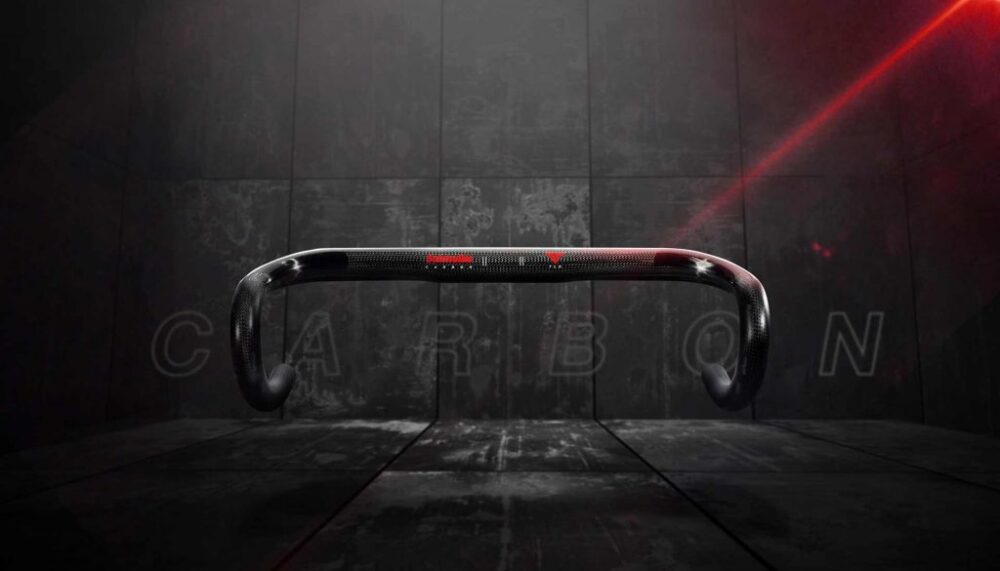
Subscribe to the newsletter and get a €50 voucher
Subscribe to our newsletter for exclusive product news and receive a sign-up bonus of 50 euros for your next order.